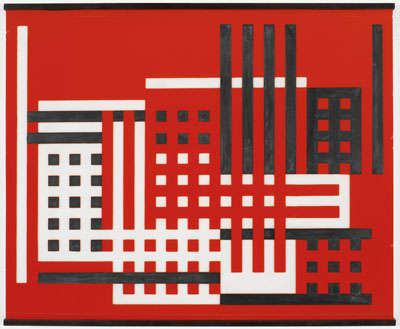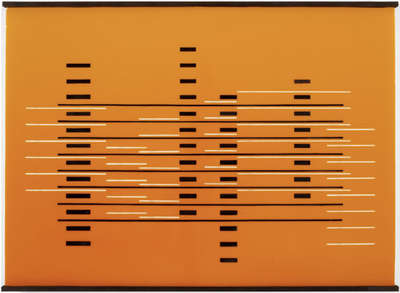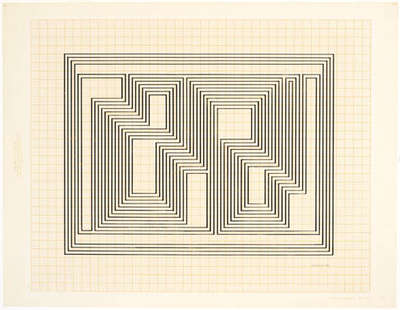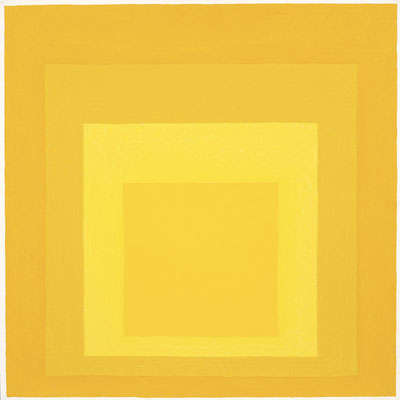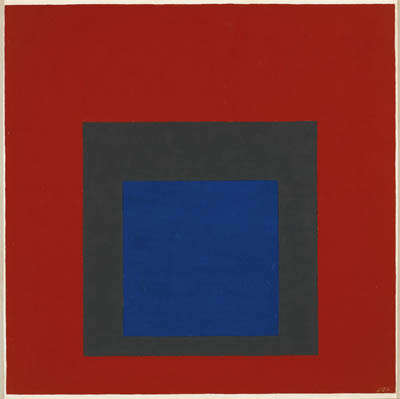| 1902–05 |
Attends preparatory teachers’ training school in Langenhorst. |
| 1905–08 |
Attends teachers’ college in Büren; receives teacher’s certificate. |
| 1908–13 |
Teaches at the public school Joseph-Schule in Bottrop, and in the nearby towns of Dülmen and Stadtlohn. |
| 1913 to 1919 |
Studies Fine Art at the Royal Art School (Berlin), Kunstgewerbeschule (Essen), Royal Bavarian Art Academy (Munich). |
| 1920 to 1922 |
Joins the Bauhaus at Weimar, takes the Preliminary Course under Johannes Itten, pursues independent study in stained glass, appointed a “journeyman” and placed in charge of the Bauhaus glass workshop. He designs and executes stained-glass windows for Walter Gropius’s Sommerfeld and Otte houses in Berlin and for the reception room of Gropius’s office in Weimar. In the furniture workshop, Albers designs a table and bookshelf for the reception room of Gropius’s office. |
| 1923 |
Takes over teaching of the Preliminary Course in material and design together with Laszlo Moholy-Nagy. He designs display cabinets to be used for the first official Bauhaus exhibition. |
| 1924 |
First published essay “Historisch oder Jetzig” ^, appears in a special Bauhaus issue of the magazine Junge Menschen. |
| 1925 |
Marries Anni Fleischmann and moves with the Bauhaus to Dessau and is appointed a Bauhaus Meister. |
| 1926 to 1927 |
Develops sandblasted glass paintings and designs large scale glass windows fabricated by the Berlin firm of Gottfried Heinersdorff, Puhl and Wagner. The windows are installed in the Grassi Museum, Leipzig, and the Ullstein Printing Factory in Tempelhof, Berlin. These windows are destroyed during World War II. He also designs an upholstered bentwood armchair, glass and metal household objects, and a universal typeface which is published in the magazine Offset. He designs furniture for the Berlin apartment of the Albers’s good friends, Drs. Fritz and Anna Moellenhoff. |
| 1928 |
Lectures at the International Congress for Art Education in Prague. His seminal article Werklicher Formunterricht, expounding his educational philosophy and method, is published in the journal Bauhaus. Takes over teaching the entire Preliminary Course after Moholy-Nagy leaves the Bauhaus. Directs the Bauhaus furniture workshop after the departure of Marcel Breuer and designs a second upholstered armchair. |
| 1929 |
Shows twenty glass paintings in an exhibition of Bauhaus masters in Zurich and Basel. His armchairs are exhibited at the Gewerbemuseum in Zurich. He heads the wallpaper design workshop for two years while its director, Hinnerk Scheper, is away in Moscow. |
| 1930 |
Continues his Bauhaus teaching as assistant director under the new directorship of Mies van der Rohe. |
| 1931 |
Designs a hotel living room with furnishings for the large Berlin Building Exhibition; begins his first sustained serial work, the Treble Clef gouaches. |
| 1932 |
Shifts to Berlin with Bauhaus from Dessau and has his first solo show at Bauhaus, a comprehensive exhibition of his work in glass from 1920–32. |
| 1933 |
Joins the remaining faculty members in officially closing the Bauhaus, after harassment by the Nazi authorities. On the recommendation of Philip Johnson and Edward M.M. Warburg at New York’s Museum of Modern Art, Albers is invited to teach at the newly-founded Black Mountain College, near Asheville, North Carolina. |
| 1934 |
Delivers three lectures at the Lyceum Club, Havana, Cuba. |
| 1935 |
The Alberses make the first of fourteen visits to Mexico. Josef makes his first abstract oil paintings. |
| 1936–41 |
More than twenty solo shows of Josef’s work in American galleries including J.B. Neumann’s New Art Circle and the Nierendorf Gallery in New York; The Germanic Museum at Harvard University; the Addison Museum of American Art, the San Francisco Museum of Art; and the Katharine Kuh Gallery, Chicago. Work shown includes glass paintings from the Bauhaus period and new graphics and oil paintings. |
| 1937 |
His paintings are included in the first American Abstract Artists exhibition at Squibb Galleries in New York City in April. |
| 1939 |
The Alberses become United States citizens. In June they travel to Mexico where Josef teaches at Gobers College in Tlalpan. |
| 1942 |
‘The Graphic Tectonics’, a series of zinc plate lithographs, begun as a series of drawings at Harvard in the summer of 1941 are executed in North Carolina. |
| 1943 |
Begins a series of geometric painted abstractions. |
| 1947 |
Spends most of this sabbatical year painting in Mexico. He begins Variant (or Adobe) series of paintings which evoke the domestic adobe architecture of Mexico. |
| 1948 |
Invited to serve on the Advisory Council of the School of the Arts, Yale University. His first post-World War II exhibition in Germany, Josef Albers, Hans Arp, Max Bill, is held at the Galerie Herbert Hermann, Stuttgart. In October, Josef agrees to be rector of Black Mountain College which is experiencing troubled times. |
| 1949 |
Resigns from Black Mountain College in March. Teaches breifly at the University of Mexico. Appointed visiting professor at Cincinnati Art Academy and at Pratt Institute, New York, where he teaches color courses. Josef makes his first linear Structural Constellation drawings and his first studies in black and white for ‘Homage to the Square’ paintings. |
| 1950 |
Starts his ‘Homage to the Square’ series of paintings. He is a visiting critic at Yale University Art School (January and February), and Visiting Professor, at Harvard’s Graduate School of Design (summer). In the fall he accepts the appointment as Chair of the Department of Design at Yale. Invited by Walter Gropius, Josef contributes to the interiors of the new Harvard University Graduate Center. |
| 1952 |
First one person exhibition at the Sidney Janis Gallery, New York. |
| 1953 |
Teaches at the Department of Architecture, Universidad Catòlica, Santiago, Chile, and at Institute of Technology, Lima, Peru. |
| 1954 |
Teaches at the University of Honolulu, Hawaii. He is appointed visiting professor at Hochschule für Gestaltung, Ulm, West Germany. |
| 1955 |
Teaches at Hochschule für Gestaltung, Ulm as visiting professor in the summer. |
| 1956 |
Yale University Art Gallery mounts a retrospective exhibition of Albers’ work. |
| 1957 |
Exhibition at Galerie Denise René, Paris. |
| 1958 |
Retires from Yale University Art School, but remains as Visiting Critic until 1960. He continues to be invited as visiting teacher to art schools across America. |
| 1959 |
Awarded a Ford Foundation fellowship. His mural “Two Structural Constellations” is engraved in the lobby of the Corning Glass Building in Manhattan. |
| 1961 |
Designs the mural “Two Portals” for the lobby of the Time and Life Building in Manhattan and a brick altar wall for St. Patrick’s Church, Oklahoma City. |
| 1962 |
Awarded a Graham Foundation fellowship and an Honorary Doctorate in Fine Arts from Yale University. |
| 1963 |
The monumental mural in red, white, and black, Manhattan, is installed in the Pan Am Building in New York, and Repeat and Reverse is installed over the entryway of Yale’s Art and Architecture building. Interaction of Color, with text and silkscreen plates based on Albers’ color course, is published by Yale University Press. |
| 1964 |
Creates the series of eight Homage to the Square images, Midnight and Noon. The International Council of the Museum of Modern Art, New York organizes the exhibition “Josef Albers: Homage to the Square” which opens in Caracas Venezuela in March 1964 and travels to museums throughout the Americas through January 1967. |
| 1965 |
Josef’s guest lecture series at Trinity College, Hartford, Connecticut is published as “Search Versus Re-Search”. |
| 1967 |
Receives the Carnegie Institute award for painting at Pittsburgh International Exhibition. |
| 1968 |
Receives the Grand Prix at the Third Bienal Americana de Grabado, Santiago, Chile, and the Grand Prix for painting from the State of Nordrhein-Westfalen, Germany. He is elected a member of the National Institute of Arts and Letters. The traveling exhibition Albers organized by the Westfälisches Landesmuseum für Kunst und Kulturgeschichte in Münster opens in Münster in April 1968 and travels in Europe through January 1970. |
| 1970 |
Officially regarded as an honorary citizen of his birthplace, Bottrop. |
| 1971 |
Albers is the first living artist to have a retrospective exhibition at the Metropolitan Museum of Art, New York. |
| 1972 |
Designs a steel sculpture “Two Supraportas” for the façade of the new Westfälisches Landesmuseum für Kunst and Kulturgeschichte in Münster. Other architectural works for this year are “Gemini”, a stainless steel relief for the Grand Avenue National Bank lobby in Kansas City, Missouri, and “Reclining Figure”, a mosaic mural for the Celanese Building in Manhattan (destroyed in 1980). |
| 1973 |
Publication of “Formulation: Articulation”, a screenprint portfolio that reprises his life’s work. Albers designs a free-standing sculptural wall for Stanford University. He receives the College Art Association’s Distinguished Teaching Award. |
| 1975 |
Receives the Fine Arts Medal of the American Institute of Architects. |
| 1976 |
At the invitation of a former student (architect Harry Seidler), Josef designs the mural Wrestling for Seidler’s Mutual Life Center in Sydney, Australia. Josef Albers dies on March 25 at New Haven, Connecticut. |
| 1980 |
Albers’ Stanford Wall (designed in 1973) is constructed on the University campus. |










